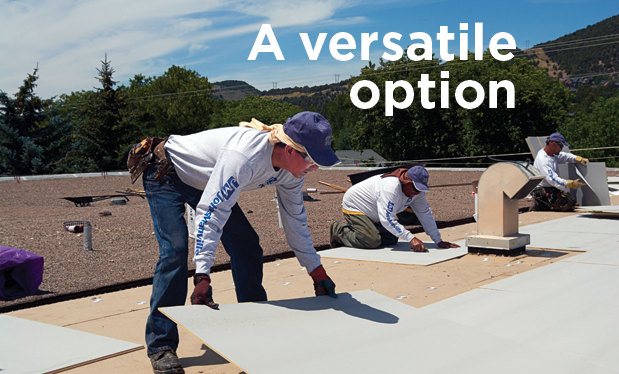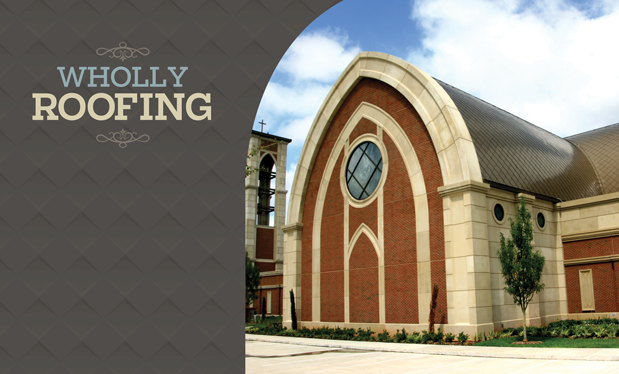SPRI, which represents manufacturers of single-ply membrane roof system products and associated accessories, also is a standards-development organization. And because some of SPRI's standards are referenced in International Building Code,® 2018 Edition (IBC 2018) and can be used as design references, designers and roofing contractors should be aware of them.
ANSI process
SPRI is an American National Standards Institute- (ANSI-) accredited standards developer. ANSI facilitates the development of American National Standards by accrediting the procedures of standards developing organizations (SDOs), such as SPRI. Accreditation by ANSI signifies the standards development procedures used by an SDO meet ANSI's essential requirements for openness, balance, consensus and due process.
There are 237 SDOs accredited by ANSI and more than 11,500 ANSI standards.
Code references
References to three SPRI standards are contained in IBC 2018.
IBC 2018's Section 1504.4-Ballasted Low-slope Roof Systems references ANSI/SPRI RP-4-2013 (RP-4), "Wind Design Standard For Ballasted Single-ply Roofing Systems," as the basis for designing aggregate and paver-ballasted single-ply membrane roof systems. RP-4 is based on ASCE 7-10, "Minimum Design Loads for Buildings and Other Structures," and limits the use of RP-4-compliant ballasted roofs to buildings 150 feet high or lower.
IBC 2018's Section 1504.8-Surfacing and Ballast Materials in Hurricane-prone Regions and Table 1504.8 Maximum Allowable Mean Roof Height Permitted for Buildings with Aggregate on the Roof in Areas Outside a Hurricane-prone Region further limit aggregate usage based on a building's mean roof height, nominal design wind speed (Vasd) and exposure category. IBC 2018 uses ASCE 7-16.
IBC 2018's Section 1504.5-Edge Securement for Low-slope Roofs references ANSI/SPRI/FM 4435/ES-1-2011 (ES-1), "Wind Design Standard for Edge Systems Used with Low Slope Roofing Systems," as a method for testing the wind resistances of edge metal flashings (except gutters) for built-up, polymer-modified bitumen and single-ply membrane roof systems.
The code specifically references ES-1's RE-1, RE-2 and RE-3 resistance test methods and not ES-1's other requirements. Tested resistances need to exceed design wind loads determined using the code's Chapter 16-Structural Design.
IBC Section 1505.10-Roof Gardens and Landscaped Roofs references ANSI/SPRI VF-1-2010 (VF-1), "External Fire Design Standard for Vegetative Roofs," as a method for design of vegetative roof systems for external fire resistance.
The code includes additional requirements for vegetative roof systems in Section 1505.10-Roof Gardens and Landscaped Roofs, Section 1507.16-Vegetative Roofs, Roof Gardens and Landscaped Roofs and in the International Fire Code's Section 317-Rooftop Gardens and Landscaped Roofs.
Other design references
In addition to the SPRI standards referenced in the code, other SPRI standards can be used as design references. These include:
- ANSI/SPRI/RCI NT-1-2017, "Detection and Location of Latent Moisture in Building Roofing Systems by Nuclear Radioisotopic Thermalization"
- ANSI/SPRI FX-2016, "Standard Field Test Procedure for Determining the Withdrawal Resistance of Roofing Fasteners"
- ANSI/SPRI GT-1-2016, "Test Standard for Gutter Systems"
- ANSI/SPRI IA-2015, "Standard Field Test Procedure for Determining the Uplift Resistance of Insulation and Insulation Adhesives over Various Substrates"
- ANSI/SPRI RD-1-2014, "Performance Standard for Retrofit Drains"
- ANSI/SPRI WD-1-2014, "Wind Design Standard Practice for Roofing Assemblies"
- ANSI/SPRI RP-14-2016, "Wind Design Standard for Vegetative Roofing Systems"
- ANSI/GRHC/SPRI VR-11-2001, "Procedure for Investigating Resistance to Root Penetration on Vegetative Roofs"
Accessing SPRI's standards
SPRI's standards are available at no cost and are accessible at www.spri.org/standards.
Mark S. Graham is NRCA's vice
president of technical services.
@MarkGrahamNRCA
To read an article related to this topic, see "Complying with ES-1," July 2014 issue.
This column is part of Research + Tech. Click here to read additional stories from this section.



